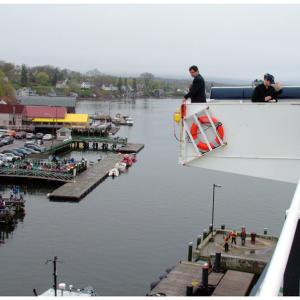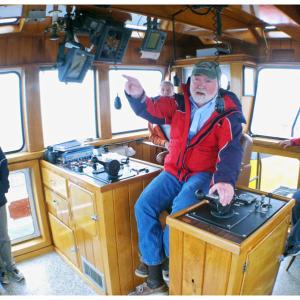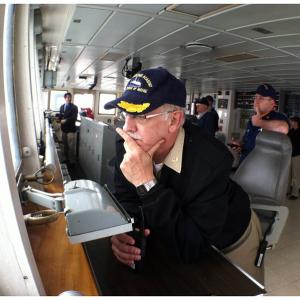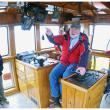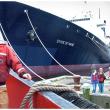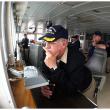Pilots and tugs: the quiet guides of Penobscot Bay
 Capt. David Gelinas of the Penobscot Bay & River Pilots Association looks down at the water in Castine Harbor from the upper deck of Maine Maritime Academy's Training Ship State of Maine for clues about the direction of the tide. (Photo by Ethan Andrews)
Capt. David Gelinas of the Penobscot Bay & River Pilots Association looks down at the water in Castine Harbor from the upper deck of Maine Maritime Academy's Training Ship State of Maine for clues about the direction of the tide. (Photo by Ethan Andrews)
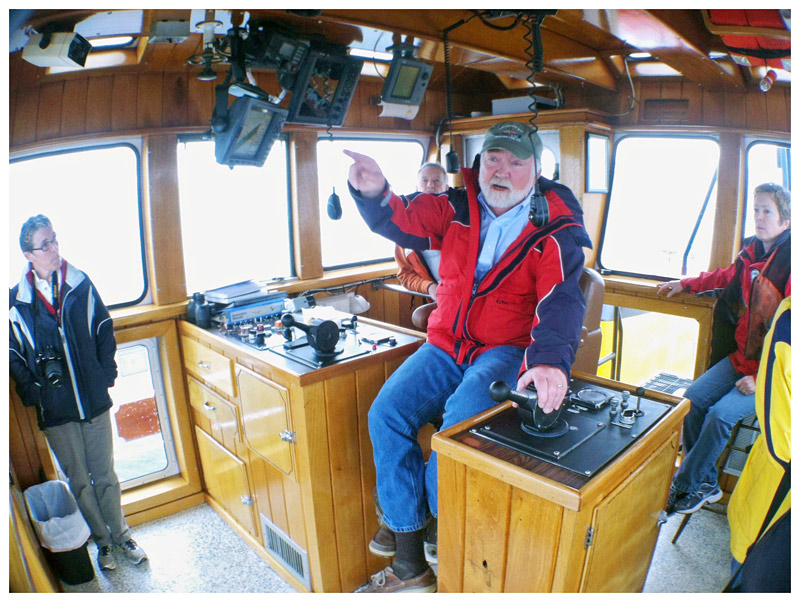 Capt. John Worth aboard one of four tugboats operated by the Penobscot Bay Tractor Tug Co. The Belfast-based subsidiary of Fournier Tugs primarily guides cargo ships and other large vessels in and out of ports in Penobscot Bay. (Photo by Ethan Andrews)
Capt. John Worth aboard one of four tugboats operated by the Penobscot Bay Tractor Tug Co. The Belfast-based subsidiary of Fournier Tugs primarily guides cargo ships and other large vessels in and out of ports in Penobscot Bay. (Photo by Ethan Andrews)
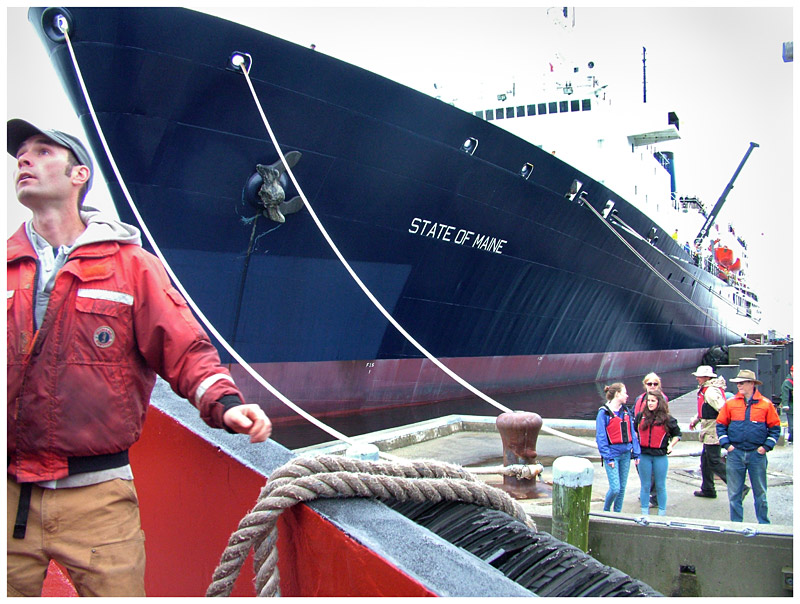 The Belfast-based tug ties up alongside the massive State of Maine in Castine. (Photo by Ethan Andrews)
The Belfast-based tug ties up alongside the massive State of Maine in Castine. (Photo by Ethan Andrews)
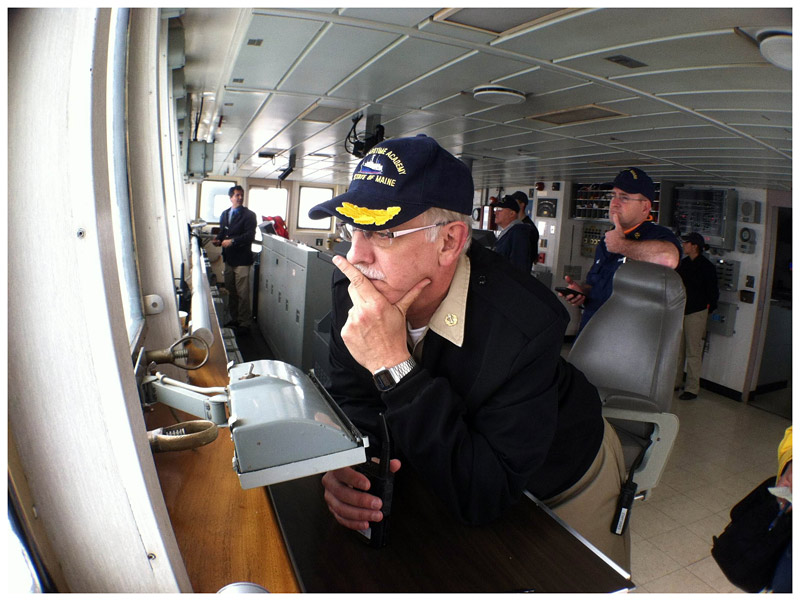 Capt. Les Eadie of Maine Maritime Academy's Training Ship State of Maine waits as Capt. David Gelinas of the Penobscot Bay & River Pilots Association, background, left, guides the ship out of port in Castine. (Photo by Ethan Andrews)
Capt. Les Eadie of Maine Maritime Academy's Training Ship State of Maine waits as Capt. David Gelinas of the Penobscot Bay & River Pilots Association, background, left, guides the ship out of port in Castine. (Photo by Ethan Andrews)
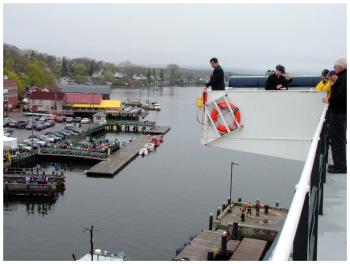 Capt. David Gelinas of the Penobscot Bay & River Pilots Association looks down at the water in Castine Harbor from the upper deck of Maine Maritime Academy's Training Ship State of Maine for clues about the direction of the tide. (Photo by Ethan Andrews)
Capt. David Gelinas of the Penobscot Bay & River Pilots Association looks down at the water in Castine Harbor from the upper deck of Maine Maritime Academy's Training Ship State of Maine for clues about the direction of the tide. (Photo by Ethan Andrews)
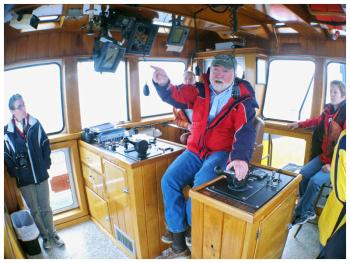 Capt. John Worth aboard one of four tugboats operated by the Penobscot Bay Tractor Tug Co. The Belfast-based subsidiary of Fournier Tugs primarily guides cargo ships and other large vessels in and out of ports in Penobscot Bay. (Photo by Ethan Andrews)
Capt. John Worth aboard one of four tugboats operated by the Penobscot Bay Tractor Tug Co. The Belfast-based subsidiary of Fournier Tugs primarily guides cargo ships and other large vessels in and out of ports in Penobscot Bay. (Photo by Ethan Andrews)
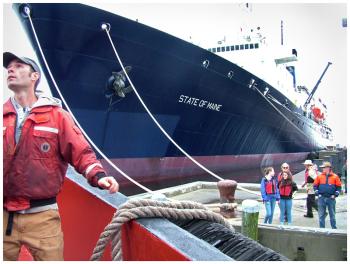 The Belfast-based tug ties up alongside the massive State of Maine in Castine. (Photo by Ethan Andrews)
The Belfast-based tug ties up alongside the massive State of Maine in Castine. (Photo by Ethan Andrews)
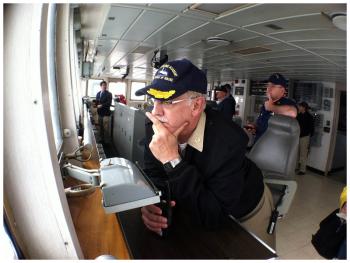 Capt. Les Eadie of Maine Maritime Academy's Training Ship State of Maine waits as Capt. David Gelinas of the Penobscot Bay & River Pilots Association, background, left, guides the ship out of port in Castine. (Photo by Ethan Andrews)
Capt. Les Eadie of Maine Maritime Academy's Training Ship State of Maine waits as Capt. David Gelinas of the Penobscot Bay & River Pilots Association, background, left, guides the ship out of port in Castine. (Photo by Ethan Andrews)
BELFAST - Some time back, Captain John Worth overheard a woman who was touring her visiting friend along the waterfront. Worth had just returned from a night of work on one of the tug boats of the Penobscot Bay Tractor Tug Co. when the woman said, “These are our tug boats. They don’t ever go anywhere, but here they are.”
Worth recounted the story with mock exasperation from the pilot's seat one of those tugs en route to Castine, where his and another tug belonging to Maine Maritime Academy had been enlisted to launch the academy's training ship State of Maine.
The annual event brings hundreds of people to the public landing. On this occasion, some had found their way to the tops of buildings for a better view. Cadets lined the rails on the upper decks of the massive ship, occasionally waving down to family and friends far below. Behind them were Castine’s stately homes and the elm trees that by the fact of having managed to escape the blight of Dutch elm disease recall historical photos of other Maine ports that weren’t as lucky.
By the time Worth reached Castine, Capt. David Gelinas of the Penobscot Bay & River Pilots Association was already aboard the State of Maine and making preparations with the ship's crew, many of whom were cadets getting some of their first hands on experience.
In some ways Gelinas' job on this day was typical of the work he does. The ship had to be launched from the dock, turned 180 degrees in coordination with the two tugboats, then navigated into open water. There he would hand it off to the ship's master Capt. Leslie B Eadie III.
National Maritime Day, May 18, will be celebrated at Heritage Park in Belfast. The public is invited to attend the event, which is hosted by thePropeller Club of the U.S., Searsport & Bucksport Chapter
Read more...
On Penobscot Bay: Training the next generation of sea captains, ship engineers, marine scientists
In other ways, the work demanded more attention than usual. The State of Maine hadn't been to sea in eight months and the novice crew would need extra guidance.
Periodically, Gelinas would step out of the control room of the ship's bridge, lean his forearms against the rail of the upper deck and stare down at the water, looking for clues that the tide had stopped coming in. A piece of seaweed bobbing slowly upriver was enough of a sign to wait.
“This isn’t like ships that run all the time,” he said. “So you try to stack things in your favor for safety.”
High tide came and the launch appeared to go flawlessly — the tugs rotating the bow of the ship in a wide arc until it was pointing toward Islesboro, Matinicus, New York — the first port of call — and eventually Tampa and San Juan Puerto Rico.
In the relatively open waters of the bay outside of Castine, Gelinas stood in a space between the wide bank of windows facing the open water — mostly obscured that day by a heavy fog — and a massive bank of instruments and controls built into the ship.
Occasionally, he checked a gauge or looked out the window, but mostly he looked at his laptop, which he carried back and forth between a small shelf on one side of the room and a more makeshift perch in one of the window bays.
The screen showed a nautical map of the bay and a handful of bullet-shaped icons indicating the location of The State of Maine, other large ships in the vicinity and tugs. A strip along the right side displayed ship speed and other numerical readings in real time.
The Penobscot Bay & River Pilots Association keeps three pilots on duty at all times to either meet ships outside the bay and navigate them to port or the reverse. The organization serves ports in the Penobscot Bay, Frenchman Bay and the Penobscot River and typically fields 150 to 170 calls per year.
The day the State of Maine was launched was particularly busy. One of Gelinas' peers had been in Bar Harbor at 5:30 that morning with the passenger ship Maasdam. Gelinas was on the State of Maine at 11:30 and probably would not disembark until around 8 p.m. Another pilot was working with a tanker called the Great Eastern at Mack Point and the pilot who had been in Bar Harbor was scheduled to meet the Zhuang Yuan Au, a Chinese ship bearing asphalt from Canada that was making a delivery at Mack Point.
"You can go four or five days and not see anything,” he said. “But then you have days like yesterday [when he said there were three calls] and today."
National Maritime Day, May 18, will be celebrated at Heritage Park in Belfast. The public is invited to attend the event, which is hosted by thePropeller Club of the U.S., Searsport & Bucksport Chapter
During the recent battles over a proposed propane terminal that would have been built near Mack Point, Gelinas testified to the effect that shipments of the fuel, which were anticipated to arrive around five times per year, did not raise any substantial concerns from a pilot's perspective.
His opinion didn’t please some opponents of the project, but then large cargo ships carrying toxic and/or flammable substances have been traveling the bay for years and the system is well organized.
Gelinas unfolded a paper chart of the area and pointed to a wide green strips entering the bay, forking to pass along either side of Islesboro then reconnecting into a single lane headed toward Searsport and the mouth of the Penobscot River. These were the established channels for commercial traffic — the highways in and out of the bay.
And as John Worth put it during the trip back to Belfast, most of the cargo that comes into Mack Point — heating oil and other types of fuel, asphalt, salt — are things that are needed locally.
"The only reason there is a Searsport or a Portland is that we're linked to the ocean. That's why we're here," he said. "Everyone needs to appreciate that this is a marine highway as well as a fishing ground."
On the more recent controversy over plans to dredge the channel leading to Mack Point, Worth again highlighted the importance of keeping the shipping lanes open.
Opponents have expressed concerns that the dredged material, called “spoils,” would damage marine habitats and fisheries. Plans for the Searsport dredging would have the spoils dumped at a site somewhere west of Turtle Head at the northern tip of Islesboro.
Spoils from most recent dredgings have gone to Rockland.
“We’ve been using that site for years and years and lobstering is at its peak,” he said. “So maybe it attracts lobsters.”
Assisting the pilots with large vessels makes up the bulk of the work of the Penobscot Bay Tractor Tug Co. — known locally for the parent company, Fournier Tugs — but the boats occasionally transport flatbed barges loaded with freight that doesn't fit cargo ship dimensions or originates from smaller ports — Cianbro’s modular buildings shipped from Mack Point and the massive fenders for nuclear submarines fabricated at Front Street Shipyard in Belfast are two recent examples.
The tugs also spend a fair amount of time in the harbor where the small crew stays busy during the downtime painting, polishing and otherwise making the boats handsome in a way that belies the rugged work they do.
In this way a person might get the idea that they don’t ever go anywhere.
______________________________________________________________________
Ethan Andrews can be reached at news@penbaypilot.com
Event Date
Address
United States

